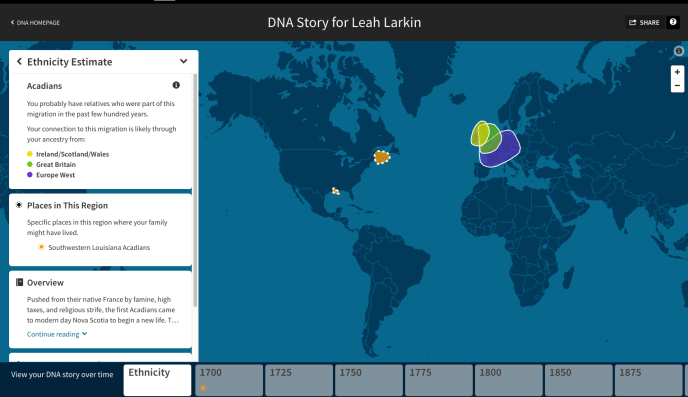In March, AncestryDNA introduced a new feature called Genetic Communities (GCs for short). At the time, I described the Genetic Communities and also summarized the scientific paper on which they were based.
For some users, the GCs will appear as subcategories of specific ethnicity categories. For example, the GC for Munster, Ireland, appears as a subgroup of the ethnicity category Ireland/Scotland/Wales.
You can distinguish an ethnicity category from a GC because the former has a solid colored dot beside it, while the dot for the latter has a thin dashed ring around it.
For people with more mixed backgrounds, their GCs will show below the ethnicity estimates as “Migrations”. This is what my Acadian group looks like.
The Ethnicity tab (selected in the image above) links my Acadian heritage to the Ireland/Scotland/Wales, Great Britain, and Europe West ethnicity categories; maps locations my ancestors might have lived; and provides some historical context.
If I click on a block of time at the bottom (1750 is selected in the image below), I can see where the ancestors in my tree lived at the time.
Clicking on the text just below the date range (e.g., “Acadians: The Grand Dérangement” in the example above) pulls up more historical information.
The Genetic Communities Challenge
I was so sure that this new feature would excite newbies into linking trees to their DNA profiles that I posed a challenge to my readers back in March. The challenge was to report how many of your top 100 matches did not have trees linked to their DNA results when the GCs were first rolled out in late March and report the same information again 6 months later, in October. If I was right, the number of no-tree matches should go down.
As an incentive, I promised a free AncestryDNA test to one lucky person who reported values both in March/April and again in October.
The results are in! Back in March/April, readers contributed data for a total of 113 unique kits at AncestryDNA. (Some readers reported on more than one kit.) Most of them didn’t report back in October, though; I only have before-and-after data for 20 kits (one of which is mine). A few new people contributed counts in October, so there was a total of 24 data points.
The average in March/April, based on 113 individual kits, was that 45.7% of the top 100 DNA matches did not have a tree linked to their DNA results. The average in October (of 24 kits) was 47.3% without trees. Looking only at the 20 people for whom I have before and after data, they averaged 43.1% of matches without trees in March/April and 47.2% in October.

In short, I was wrong. Genetic Communities do not seem to have encouraged more new testers to link trees to their DNA results. (Perhaps even fewer new DNA testers would have linked trees without the feature, but I have no way of gauging that.) As much as I hate being wrong, glad that we have some hard numbers to address this question, and I’m grateful for all my readers who contributed data.
And the Winner Is …
I picked one contributor at random from among the 19 reports that included both before and after data. (I excluded myself from the pool before the random drawing.) Congratulations to Nancy Marek!
Thank you all for taking the time to share your data for this little experiment!
This post was updated on 21 November, 2017, to clarify how Migrations are related to Genetic Communities and to name the winner of the DNA test (with her permission).




Well that stinks! Are we, the super-users of Ancestry.com the only ones who think that the lack of trees paired with DNA profiles is a problem? It seems to me, a former email marketer, that at the very least, Ancestry could create a trigger email that would go out twice a year or so that could say, “Hey, you have a tree, here’s how you connect it! And the benefits to you are…” This would be so easy. Beyond that, of course are the people with no tree at all, an email that would go to them about building a tree, it seems, would possibly result in more trees paired with DNA and possibly more Ancestry subscriptions sold as people got into their tree/DNA combination and got “hooked”. I wonder why Ancestry isn’t doing this? If only I worked there/had an in… 🙂
I think they are! I have a dummy account with Ancestry that generates an email every month or so. There’s a trade-off, though, because I become numb to repeat emails (not just from Ancestry) and usually delete them without ever reading them.
That said, there are more trees linked to DNA at AncestryDNA than elsewhere, so they’re doing something right.
Its pretty frustrating when checking DNA matches only to see that the person you may have a link to does not have a tree attached to their DNA results which makes validating the linkage all the more difficult
Yes, it is frustrating! I have pretty good success in reaching out if I do some legwork first: I check shared matches to see if I can pinpoint them to one branch of my tree, then I tailor my message to them based on that info. Some never respond, but there are plenty that do.